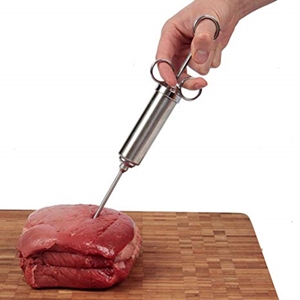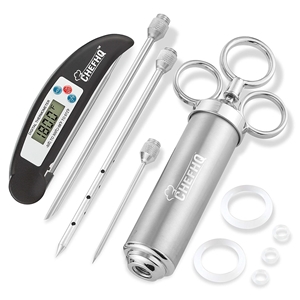Briskets are one of the most delicious parts of beef if they’re prepared right. However, they’re so easy to get wrong, ending up leathery and super hard to chew up. There’s a simple reason for this – briskets do a heavy-duty job. They carry around 60% of a 1.5 K pound heavy animal. That’s a lot of work, and because of that, briskets come from very tough muscles. The end results? A chunk of meat that has to be prepared a certain way to reach great taste.
So, how exactly can you do that? First of all, briskets are always cooked low and slow. This usually means barbequing for upwards of 9 hours in a kamado grill or offset charcoal smoker. And when you decide to invest most of the day on cooking something like that, you surely want to make it worth your while. Besides time, preparing a mouth-watering chunk of brisket also requires a great marinade recipe.
Today, we’ll explore the wonderful world behind brisket injection. We’ll talk about injection itself, the way to do it, the right tools for it, and finally, we’ll let you in on 5 of our most beloved marinade recipes. So, let’s dive right in!
1. Injecting Meat – The Whys and The Hows
 First of all, what is injection, and why do it? It’s just as it sounds – injecting marinade into the meat, below skin or surface. So, how does it differ from marinating? And is there more to the technique? Let’s see…
First of all, what is injection, and why do it? It’s just as it sounds – injecting marinade into the meat, below skin or surface. So, how does it differ from marinating? And is there more to the technique? Let’s see…
1.1 The difference between marinating and injecting
You might think that that’s not much different than marinating the surface and leaving it a bit to soak, but that’s not entirely true. Namely, marinating will only give flavor to the part of meat just below the surface, no matter how long you let it sit. Marinating makes the bark taste heavenly, of course, and we’re proponents of doing it. However, in meat that’s cooked in large chunks, like beef brisket, it creates a problem – the bark is too tasty, so the insides can’t compare. This is the exact reason we inject marinade into the meat as well.
Furthermore, it’s a great idea to inject meats that are drier or chewier, like beef brisket or turkey. The naturally tough chunks of meat lack the fats which will make the cooked meat pleasant to chew. With injection, you add grease or oils which will soften the meat, making it more alike to the restaurant grade BBQ that melts in your mouth. Actually, injection doesn’t only utilize fats and oils to soften the meat, but also some substances like vinegar, citrus or pineapple juice, which will help dissolve the collagen inside the chunk – the very substance that makes these parts of a cow so tough to gnaw.
1.2 What is needed for injection?
The process itself is as simple as it sounds – you literally use a large syringe (which is different than the hypodermic one, but more on that later on) to inject marinade below the surface of the meat.
1.3 When and how much?
Injecting is done anywhere between 12 hours and 30 minutes before putting the brisket on the coal. While chefs disagree on the exact length, we think it isn’t necessary to leave it standing for a long time, in contrast to marinating. Usually, an hour or two will do the trick. One thing is sure, though – if your injection contains pineapple juice or vinegar, don’t let it stand for longer than a few hours. These ingredients break down collagen, which briskets are chockfull of, making it mushy and too gelatinous. Don’t get us wrong though – these ingredients are amazing for tenderizing, just don’t use them too much or for too long. Also, as pineapple juice can leave a bit too much flavor behind, most chefs prefer vinegar to do this task.
You can expect to use around 1 ounce of injection per a pound of meat, but feel free to prepare more. That’s because you can use the same marinade to inject and to rub the surface of the brisket with. On the other hand, you also don’t have to worry about injecting too much, as that’s virtually impossible. The meat can only take so much, and the liquid will pour out if you try to squeeze too much in.
1.4 Which part?
When it comes to full packers, you can choose whether you want to inject only the flat (the larger part of the brisket), or both the flat and the point. Being the inner part of the muscle that carries most of the weight, the flat is much leaner compared to the fattier point that doesn’t do as hard of a job. Being that the point naturally contains more fat, the injection isn’t necessary to tenderize it. However, if you’d like to add the injection to add flavor, you should definitely go for it.
1.5 How to inject?
When injecting brisket, whether the flat or the point, you should try to do it evenly throughout. Inject in a checkerboard pattern, with punctures 1 inch apart from one another.
Puncture the meat with the needle, pushing it in completely. A typical kitchen injector will go a bit more than halfway through an average brisket. Press the plunger of your syringe as you’re drawing the needle out of the meat. If you inject too much, the liquid will pour out. Similarly, if you inject the liquid too quickly, it will not only pour out but squirt. This can be messy, so some chefs like to inject while holding their hand over the puncture. In any case, don’t get startled if this happens, just try to push less marinade out on the next try. The learning curve is not steep, and you will get the hang of it very quickly.
When it comes to the direction of puncturing through the meat, there are two schools of thought. While all agree that you should insert the needle at an angle and not perpendicular to the surface. However, some pit masters argue that the right way is injecting against the grain, while others believe that you should go along with it. The important thing that everyone agrees on, though, is that you should get the injection even throughout the chunk. Feel free to experiment and figure out the way that feels (and tastes) better to you!
1.6 Any other steps?
Finally, if you plan on rubbing the meat or adding a layer of crust in another way, make sure to wipe any injection that ends up on the surface of the brisket with a paper towel. If you choose not to, parts of your rub might end up falling off later. There’s no need to do this if you only plan to marinate, though.
2. The Right Tools
 Now that we’ve covered the ins and outs of injecting, let’s help you get the right tool for yourself. If you’re getting a kitchen injector for the first time, read on to find out what you should look for when choosing one. If you already have a tool that you use and love, feel free to skip this part, or read on for a brush-up.
Now that we’ve covered the ins and outs of injecting, let’s help you get the right tool for yourself. If you’re getting a kitchen injector for the first time, read on to find out what you should look for when choosing one. If you already have a tool that you use and love, feel free to skip this part, or read on for a brush-up.
First of all, how does a kitchen syringe differ from a typical hypodermic one they use at the hospital? While size might be the most obvious answer, that’s not all of it. Let’s take a look:
- Starting at the top, the plunger is the part which you press. It runs through the syringe, pushing the fluid out through the needle as you apply pressure on the other end. Apart from the size, the anatomy of different meat syringes will mainly only differ in the plunger shapes. Some have three finger holes which make them feel nice and secure in your hand, while others have a simpler, flat flange shape. Either way, this movable part of the injector will be the one that’ll let you know if something’s gone awry. If it gets hard to push the plunger, a piece of seasoning might be stuck in your needle, or you might need to water your solution down. It’d be best to get a meat injector with a metal plunger compared to the plastic ones, as metal is much easier to clean, doesn’t retain smell, and is more durable. However, if you’re looking for a more affordable option, plastic works just as well!
- The barrel is the container of fluid in the syringe. These are typically quite large, containing 2 ounces of liquid or more. Depending on your preferences (and how precise you like to be when preparing food), you can choose to get a transparent plastic barrel or an opaque metal one. In any case, it’d be best to get a graded one.
- The needle is the most important part of a meat syringe and the one that is the most different from the hypodermic ones. While the medical tool sprays the fluid from the tip of the needle, that’s not the case with this kitchen utensil. There are different types of needles, but all of them let liquid out at the sides. Some have two holes, but there are some with as many as 12 holes. This distribution of holes makes the injected marinade spread more evenly. However, it also makes the syringe somewhat harder to fill up, so make sure you use a deep glass instead of a wide bowl when you prepare to inject.
Finally, let’s go through some general characteristics you should look out for when choosing an injector.
- Injectors with steel parts are more expensive but also easier to clean and more durable than the plastic ones. If you have the means to invest in a stainless-steel injector, we highly recommend opting for it instead of plastic.
- By definition, injectors will always end up very greasy and dirty, so getting a dishwasher safe model will surely save you some trouble.
- If you’re eager to experiment with different meats and marinades, it’d be a great idea to get a set of needles with different size and number of holes.
3. Overview Of Injection Ingredients And Tips
 Finally, do you hope to make your barbeque the most unforgettable delicacy your family and friends won’t be able to stop talking about? Let’s talk about the actual marinades you can prepare to make that wish come true.
Finally, do you hope to make your barbeque the most unforgettable delicacy your family and friends won’t be able to stop talking about? Let’s talk about the actual marinades you can prepare to make that wish come true.
While we will write about 5 of our most favorite injection recipes, you should feel free to experiment and tinker according to your own preferences. Of course, ready-made and powder injections are available in most grocery stores, but we feel that nothing quite beats the home-made blends made exactly how you like it.
The Common Ingredients
We’d love to encourage experimentation because we believe you might discover the recipe for the next BBQ sensation if you do. Because of that, we will cover the basic ingredients most injection marinade recipes use. Give or take some seasoning or a choice of the ingredient, and you can go on creating your own recipes in no time. So, let’s take a look at the most common ingredients that appear in most brisket injection recipes.
- Beef stock, broth, au jus, consommé, or bouillon – These are used as a primary ingredient in any injection recipe. These are not completely interchangeable, but in many cases, you can use whichever you have at hand. In fact, if you don’t want to add any seasoning or tenderizing agent, you may use it as an injection alone. This ingredient will, of course, intensify the flavor of the beef to the max. However, it will also add a bit to the texture. In the cases of greasier or oilier choices, you may avoid the following ingredient, which is…
- Melted butter or oil, especially olive oil – These are added to soften up the tough brisket, especially if it’s trimmed, meaning that it lacks the layer of its own fat to keep it juicy. While the natural fat layer that comes with untrimmed briskets keeps the juiciness in by not allowing it to evaporate during the cooking process, the additional butter or oil serves as an additional source of moisture from within the meat.
- Worcestershire or hot sauce, and cayenne pepper – These are added purely to enhance the flavor of your brisket. Feel free to choose whichever you like the most, and add as much as you think you should. Of course, if you’re using hot sauce, make sure you know the hotness because you can always add more to the marinade and the rub, but there’s no going back if you add too much to the injection!
- Cognac, beer, or whiskey – Another ingredient added purely for its flavor, alcohol is an amazing addition that complements the meaty deliciousness of a brisket. Apart from alcoholic drinks, another popular beverage that’s used to add flavor to briskets is coffee, and some people even like making theirs with Coke. However, we find the flavor of the sugary drink somewhat overpowering, so we only recommend it to true soda devotees.
- Vinegar – Though it’s not usually included in injection recipes, you can add a little bit of vinegar in order to tenderize the meat. Some chefs vouch for apple vinegar and/or apple juice, while others avoid it completely. If you know you have an especially tough chunk, we recommend adding no more than a tablespoon or two of apple or other kinds of vinegar to your concoction and injecting the fluid less than 4 hours before cooking. Bear in mind that while pineapple and citrus juice can do essentially the same tenderizing job. However, these leave a much stronger taste and smell than apple does, so we would recommend avoiding them.
- Salt – While you may instinctively wish to add salt to the injection recipe, beware of adding too much. Only add some if broth, consommé or similar product you used is labeled “low sodium”. If it has this label, that means that it isn’t very salty. However, if it isn’t specifically tagged, it’s safe to assume the product is salty enough as it is, and you don’t need additional salt. Unless, of course, you’re big on extra salty food – in which case you can sprinkle away.
Any other ingredients you find in injection recipes are most likely added for flavor. We strongly encourage experimenting with your own favorite seasonings.
However, a word on advice on adding seasonings – if you want to use any solids, even minced herbs or garlic, make sure to go the extra mile to grind them into very fine powders. As the injection must go through the holes of the needle, all pieces must be much smaller than the said hole. Otherwise, you’ll unnecessarily spend a lot of time on needle unclogging and cleaning.
Now that that’s said, let’s move onto our top recipe picks! Now let’s fire that grill up!
4. Our Top 5 Brisket Injection Recipes
4.1 Garlic Based Brisket Injection Recipe
- 2 cups Water
- 2 cups preferred Low-sodium Beef Stock
- 1 tablespoon Brown Sugar
- 2 tablespoons Salt
- 2 teaspoons Worcestershire Sauce
- 2 cloves or 1 teaspoon finely ground Garlic
This simple yet incredibly tasty garlic-based recipe will leave you with mouth-watering brisket.
It’s up to you whether you’d prefer to cut fresh garlic or add a pre-made ground one. If you have the patience and know your way around a knife, we recommend cutting garlic cloves as they have a much more intense flavor. However, pay attention to making the pieces smaller than the needle holes.
For this recipe, it’s enough to use warm water and mix it with the low sodium beef stock. After these are mixed homogenous, add the other ingredients one by one. Let it stand for a bit, and you’re ready to inject!
4.2 Beefy Beef Brisket Injection Recipe
- 2 teaspoons preferred Low sodium Beef Base
- 2 cups Water
- 1 tablespoon Soy Sauce
- 1 tablespoon Worcestershire Sauce
- 1 teaspoon Monosodium Glutamate (MSG), or salt (optional)
This recipe favors the natural flavors of beef, enhancing them with just a bit of complementary sauces. As both Soy and Worcestershire sauces include a lot of salt, you can avoid, or you can freely add salt or MSG to your taste.
For this recipe, you’ll need to cook a little bit. First, bring the water to a boil in a small pot. Add the beef base and stir until homogenous. Then, add the other ingredients little by a little while stirring them in. Once the ingredients are brought together, remove the pot from the stove. Let it cool down for about 15 minutes. Once it’s cool, you’re ready to inject!
4.3 Beefy Coffee Delight
- 1 oz package preferred Au Jus Powder
- 2 cups Black Coffee
- 1 tablespoon Worcestershire Sauce
- 1 tablespoon Dry or Paste Mustard
- 1/4 cup Vegetable Oil
This delicious coffee-based recipe will end up with a flavorful brisket. The amounts and the choice of ingredients are tinkered to perfection until the flavor of coffee perfectly complements, but never overpowers the meat.
First of all, mix coffee and au jus powders. In another dish, whisk the oil and the mustard until they’re homogenous. Then, add Worcestershire sauce to the oil-mustard mix. Finally, mix the coffee and au jus with the oil and mustard. Injection ready!
4.4 Super Beefy Injection
- 2 cups Low sodium Beef Broth
- 2 cubes Beef Bouillon
- 2 tablespoons Worcestershire Sauce
- 1 teaspoon Ground Thyme (optional)
If there’s nothing you like more with your beef than more beef, this recipe is perfect for your BBQ!
In a small pot, warm beef broth until it boils, then add the bouillon cubes and Worcestershire sauce. Finally, once this mixture is homogenous, stir in thyme for some extra zest!
4.5 Pepper, Pepper, Onion
- 2 cups Beef Broth
- 2 tablespoons Ground Black Pepper
- 1 tablespoon Onion Powder
- 1 teaspoon Kosher Salt
- 2 teaspoons Brown Sugar
This simple, yet delicious recipe requires no boiling. Instead, you can simply add all ingredients and mix them in a small bowl. It’s ready to inject straight away, so it’s a perfect choice for making one when out grilling in nature, or when you simply don’t want to spend time at the stove.
Wrap Up
So, that’s all the advice we have on injecting brisket. Hopefully, you’ll try out our recipes and see exactly why we picked these. If you follow our advice closely, we guarantee a heavenly piece of brisket that comes with flavors you can’t even get in a restaurant.
If you tried out one of our recipes and want to brag with the results, or you have some of your own advice to share through GrillnSkill, we welcome you to do so in the comment section below! Now, let’s fire up that grill!
